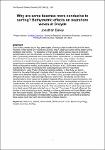Why are some beaches more conducive to surfing? Bathymetric effects on nearshore waves at Croyde
| dc.contributor.author | Bailey, J. | |
| dc.date.accessioned | 2023-12-22T16:29:58Z | |
| dc.date.available | 2023-12-22T16:29:58Z | |
| dc.date.issued | 2023 | |
| dc.identifier.citation |
Bailey, J. (2023) 'Why are some beaches more conducive to surfing? Bathymetric effects on nearshore waves at Croyde', The Plymouth Student Scientist, 16(2), pp. 1-26. | en_US |
| dc.identifier.uri | https://pearl.plymouth.ac.uk/handle/10026.1/21849 | |
| dc.description.abstract |
Good surfing waves require high peel angles, allowing surfers to ride the face of the wave. However, these waves are not present at every beach, leading to some having better surfing conditions than others. The production of high-quality surfing waves requires preliminary transformations such as refraction, to occur on the nearshore wave field. Mead and Black (2001), previously assessed how various bathymetric combinations, or components, affected the wave field at world-class surfing breaks. More recently, many articles have been published as a result of advancements made in numerical wave modelling, enabling a comprehensive evaluation of the impact these components have on the nearshore wave. While not focused on surfing, such studies as Rijnsdorp et al. (2020) were successful in quantifying the impact of structures like submerged wave farms on nearshore hydrodynamics, using Phase-Resolving numerical models. In this study, we aim to determine the extent bathymetric features affect the nearshore wave field and how this makes some beaches better for surfing than others. Using a phase-resolving dispersive diffraction-refraction model and high-resolution bathymetry, we identify the key wave transformations which occur due to bottom-induced effects and wave-wave interactions, and then further recognise how these effects alter the wave field, causing better surfing waves at Croyde Beach. The reef, located off Croyde Beach, was found to have a large influence in producing 'A-frame' waves during low tide. This was primarily due to wave focusing caused by incident waves that were refracted around the reef. The shape of the reef influenced the location of the focusing focal point, resulting in higher-quality waves at Croyde Beach rather than the closely located, Saunton Sands. This shows offshore morphology has a big effect on the presence and location of these better-quality surfing waves, and efforts to preserve these waves could start with the preservation of these features. | en_US |
| dc.language.iso | en | en_US |
| dc.publisher | University of Plymouth | en_US |
| dc.rights | Attribution 3.0 United States | * |
| dc.rights.uri | http://creativecommons.org/licenses/by/3.0/us/ | * |
| dc.subject | Nearshore | en_US |
| dc.subject | Waves | en_US |
| dc.subject | Wave Model | en_US |
| dc.subject | 2D Numerical model | en_US |
| dc.subject | Beach morphology | en_US |
| dc.subject | Coastal dynamics | en_US |
| dc.subject | Surfing | en_US |
| dc.title | Why are some beaches more conducive to surfing? Bathymetric effects on nearshore waves at Croyde | en_US |
| dc.type | Article | en_US |
| plymouth.issue | 2 | |
| plymouth.volume | 16 | |
| plymouth.journal | The Plymouth Student Scientist |



